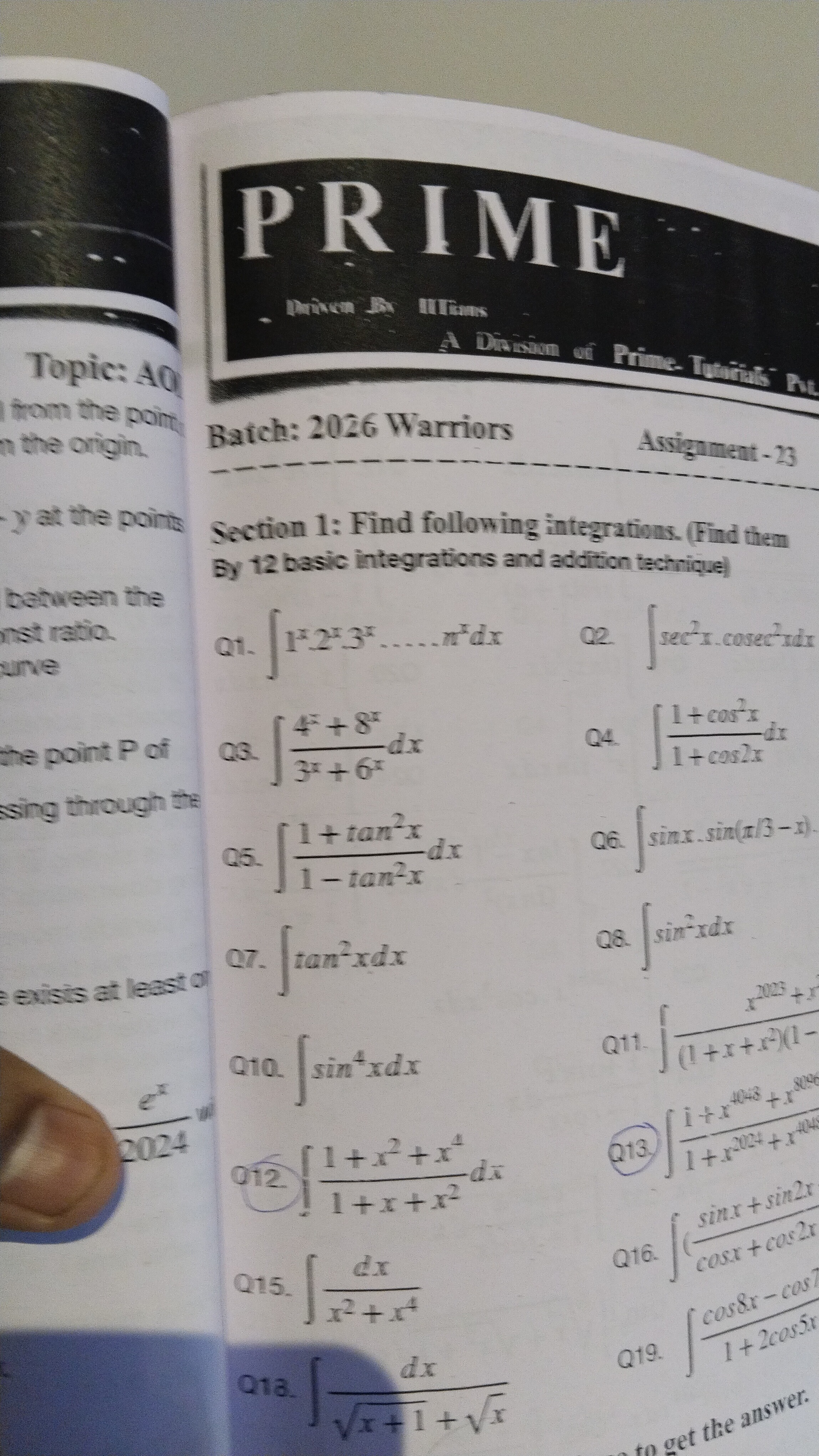Question
Question: Find the following integrations. (Find them By 12 basic integrations and addition technique) Q1. $\...
Find the following integrations. (Find them By 12 basic integrations and addition technique)
Q1. ∫1x.2x.3x.....nxdx Q2. ∫sec2x.cosec2xdx
Q3. ∫3x+6x4x+8xdx Q4. ∫1+cos2x1+cos2xdx
Q5. ∫1−tan2x1+tan2xdx Q6. ∫sinx.sin(π/3−x).
Q7. ∫tan2xdx Q8. ∫sin2xdx
Q10. ∫sin4xdx Q11. ∫(1+x+x2)(1−x+x2)x2023+x4048dx
Q12. ∫1+x+x21+x2+x4dx Q13. ∫1+x2024+x40481+x4048+x8096dx
Q15. ∫x2+x4dx Q16. ∫cosx+cos2xsinx+sin2xdx
Q18. ∫x+1+xdx Q19. ∫1+2cos5xcos8x−cos7xdx

Q1. ln(n!)(n!)x+C Q2. tanx−cotx+C Q3. ln(4/3)(4/3)x+C Q4. 21tanx+21x+C Q5. 21ln∣sec2x+tan2x∣+C Q6. 41sin(2x−π/3)−41x+C Q7. tanx−x+C Q8. 2x−4sin2x+C Q10. 83x−4sin2x+32sin4x+C Q11. 2023x2023+C (Assuming a typo for simplification) Q12. x−2x2+3x3+C Q13. x−2025x2025+4049x4049+C Q15. −x1−tan−1x+C Q16. −ln∣cosx+cos2x∣+C Q18. 32(x+1)3/2−32x3/2+C Q19. $\frac{\sin3x}{3} - \frac{\sin2x}{2} + C
Solution
Here's the solution to each integration problem, adhering to the specified format and techniques.
Q1: The product 1x⋅2x⋅⋯⋅nx simplifies to (n!)x. This is a standard exponential integral ∫axdx=lnaax+C.
Q2: Rewrite sec2xcsc2x as cos2xsin2x1. Use the identity sin2x+cos2x=1 in the numerator, then split the fraction into cos2x1+sin2x1=sec2x+csc2x. Integrate each term.
Q3: Factor the numerator as 22x(1+2x) and the denominator as 3x(1+2x). Cancel the common term (1+2x). The remaining integral is ∫3x4xdx=∫(34)xdx, which is a standard exponential integral.
Q4: Use the identity 1+cos2x=2cos2x. Split the fraction into 2cos2x1+2cos2xcos2x=21sec2x+21. Integrate each term.
Q5: Use the identity 1+tan2x=sec2x. Rewrite the denominator 1−tan2x as cos2xcos2x−sin2x=cos2xcos2x. The integral simplifies to ∫cos2x/cos2xsec2xdx=∫cos2x1dx=∫sec2xdx. This is a standard integral.
Q6: Use the product-to-sum identity 2sinAsinB=cos(A−B)−cos(A+B). Apply it to sinxsin(π/3−x), then integrate the resulting cosine terms.
Q7: Use the identity tan2x=sec2x−1. Integrate each term.
Q8: Use the identity sin2x=21−cos2x. Integrate each term.
Q10: Rewrite sin4x as (sin2x)2. Apply sin2x=21−cos2x twice, first to sin2x, then to cos22x using cos2θ=21+cos2θ. Simplify the expression and integrate term by term.
Q11: The denominator simplifies to (1+x+x2)(1−x+x2)=1+x2+x4. Assuming a likely typo for this type of problem to fit "12 basic integrations", if the numerator was x2022(1+x2+x4), the integral simplifies to ∫x2022dx.
Q12: Factor the numerator 1+x2+x4=(1−x+x2)(1+x+x2). Cancel the common factor (1+x+x2) with the denominator. Integrate the resulting polynomial 1−x+x2.
Q13: Let y=x2024. The integral transforms to ∫1+y+y21+y2+y4dx. Similar to Q12, this simplifies to ∫(1−y+y2)dx. Substitute back y=x2024 and integrate the polynomial.
Q15: Factor the denominator as x2(1+x2). Use the identity 1=(1+x2)−x2 in the numerator to split the fraction into x21−1+x21. Integrate each term.
Q16: Recognize that the numerator is almost the negative derivative of the denominator. Let f(x)=cosx+cos2x. Then f′(x)=−sinx−2sin2x=−(sinx+sin2x). The integral is of the form ∫f(x)−f′(x)dx=−ln∣f(x)∣+C.
Q18: Rationalize the denominator by multiplying by the conjugate x+1−x. The denominator becomes (x+1)−x=1. The integral simplifies to ∫(x+1−x)dx. Integrate each term using the power rule ∫undu=n+1un+1.
Q19: This problem requires advanced trigonometric identities. Use cosA−cosB=−2sin(2A+B)sin(2A−B) for the numerator. For the denominator, use the identity 1+2cos(nθ)=sin(nθ/2)sin(3nθ/2) or derive it by multiplying by 2sin(5x/2). The denominator 1+2cos5x=sin(5x/2)sin(15x/2). After substitution and cancellation, the integral becomes ∫−2sin(x/2)sin(5x/2)dx. Use the product-to-sum identity −2sinAsinB=cos(A+B)−cos(A−B) again. Integrate the resulting cosine terms.
